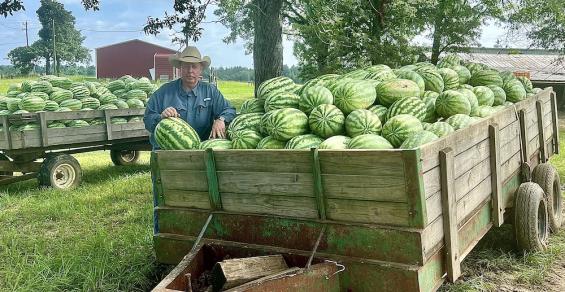Watermelon farming is a family tradition on this row crop operation.
Pete Rutland is a lifelong farmer near Mize, Miss. He plants close to 2,000 acres of row crops each spring — cotton, peanuts and soybeans — and grazes around 3,000 stocker calves each winter.
But from mid-June to late-July his focus is narrowed in on an 80-acre portion of the farm — the watermelon crop.
“We love growing watermelons. We’ve grown them on this farm as long as I can remember, and my daddy grew them before me. Watermelons are a family tradition,” said Rutland.
Rutland and his wife, Michelle, grow around 75,000 watermelons each summer. Their melons consist of mainly three varieties — Royal Sweet, 720 and Starbrite — all large, seeded, red-fleshed types. But they do grow some yellow-fleshed watermelon varieties, too.
When we spoke to Rutland, watermelon harvest was in full swing.
“Harvest runs about four weeks. We generally start around the 15th of June and finish between the 15th to 20th of July,” he said.
“During that time, we gather melons each morning, load them on a truck and get them in stores within hours. We ship most of our melons through Sunrise Fresh Produce in Clinton, Miss. We also load a lot of peddlers each morning who will sell our melons at farmer’s markets and roadside stands,” he said.
Trailers being loaded after a morning harvest to distribute to retailers.
Local crews help the Rutlands gather watermelons each summer.
“It’s a labor-intensive job, and it gets more expensive each year, but we love to grow them,” Rutland said.
Sweet spot for melons
Mark Twain once said those who have tasted watermelon “know what the angels eat.” Many would agree that it is hard to imagine a better treat on a hot, summer day.
Watermelon consumption and production in the United States has been on the rise in the last few decades, according to the Agricultural Marketing Resource Center. The organization estimates U.S. annual per capita consumption of watermelon is now at approximately 15.5 pounds per person.
Mississippi is not a large watermelon producing state. With only a few dozen commercial watermelon producers, the state averages less than 1% of the U.S. market share, according to USDA data. But residents there will argue it’s a quality over quantity thing.
“We grow good watermelons here,” Rutland said.
Smith County, where Rutland farms, is about an hour southeast of Jackson, Miss. It’s an area known historically for watermelon production. It’s home to a long-running watermelon festival. And the county is recognized by many Mississippians as producing some of the sweetest watermelons in the state. Some say the secret is in the soil.
“It’s partly the ground, partly the grower and all the Good Lord,” Rutland said.
Rutland grows around 75,000 watermelons each summer. His melons consist of mainly three varieties — Royal Sweet, 720 and Starbrite.
However, in Smith County, watermelon production has declined in recent years.
“There are not many people that grow melons around here anymore. It’s just so labor intensive and hard to get help,” he said.
“Growing a melon is a lot of work. When people walk in a store and see a $10-$15 watermelon, that is really a cheap fruit when you consider what it costs to get it produced and trucked to the place. There’s more to it than most realize,” he added.
Rising costs
Like everything else production costs for watermelons have soared this season.
“The cost of everything has gone up so much this year. From the plastic we lay to the irrigation hoses, to the seed itself. Fertilizer made a big jump. Trucking and transportation has gone through the roof. We’ve had to water more because it has been so dry. Everything has gone up astronomically,” Rutland said.
Rutland irrigates all of his watermelon acres using drip irrigation. While Rutland’s melons got a late start due to spring rains, they’ve performed well through the dry conditions of the summer.
“It was extremely wet last year and everyone I talked to had a tough time,” he said. “We just never could set a crop. The soils were saturated, and the melons just didn’t get big enough. In some fields, we didn’t gather anything.”
“Even though it’s been extremely dry this year, the crop has looked good.”
Diversified operation
Of course, watermelon production is just one part of the Rutland operation. During the heart of melon gathering, it’s also time to spray cotton and apply gypsum to peanuts. When watermelon harvest ends, Rutland will almost immediately turn his attention to purchasing stocker calves, which he does each August and September. He buys them at 350 pounds and ships them in April and May at 650-700 pounds.
Cotton, peanut and soybean harvest are not too far off, either. And then it all starts over again in February, when Rutland gets next season’s watermelon crop started in his greenhouses. He’s a busy man, but he is quick to give credit to his wife, Michelle, lifelong friend and “right-hand man” Bobby Sullivan, consultant, Trey Bullock, and great part time employees whose efforts have all contributed to the farm’s success.
“We love what we do. Farming is a lot of work, but I tell people we haven’t worked a day in our lives because we love to farm,” Rutland said.
“We’re so diversified that no two days are ever the same,” he added. “It’s an awesome job.”
Watermelon festival
The 44th annual Mississippi Watermelon Festival will be held July 15-16, 2022 in downtown Mize, Miss.





